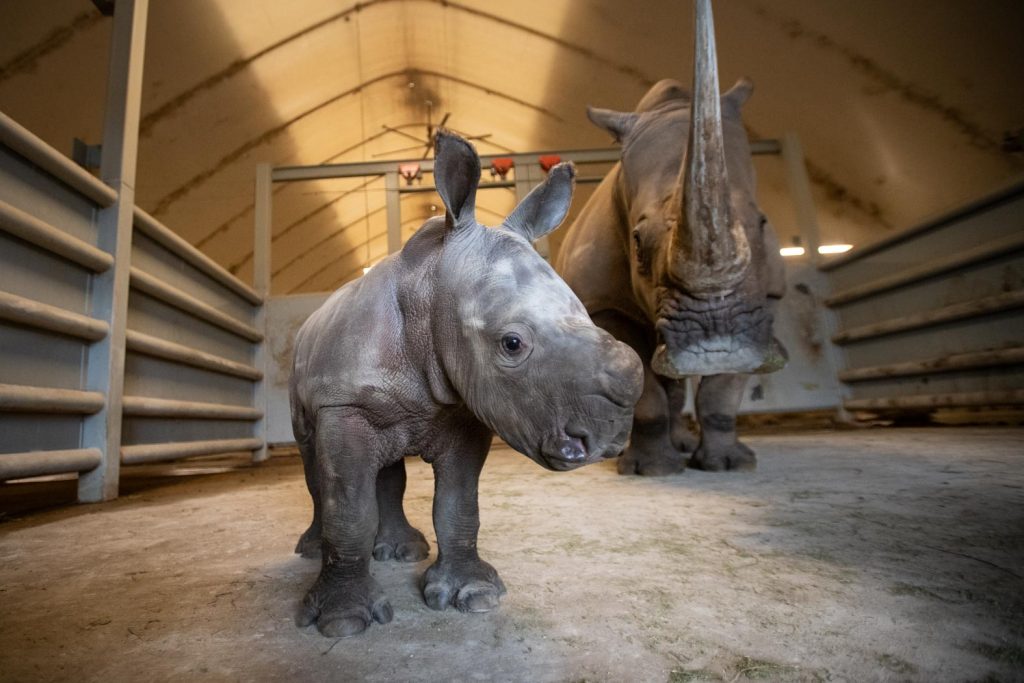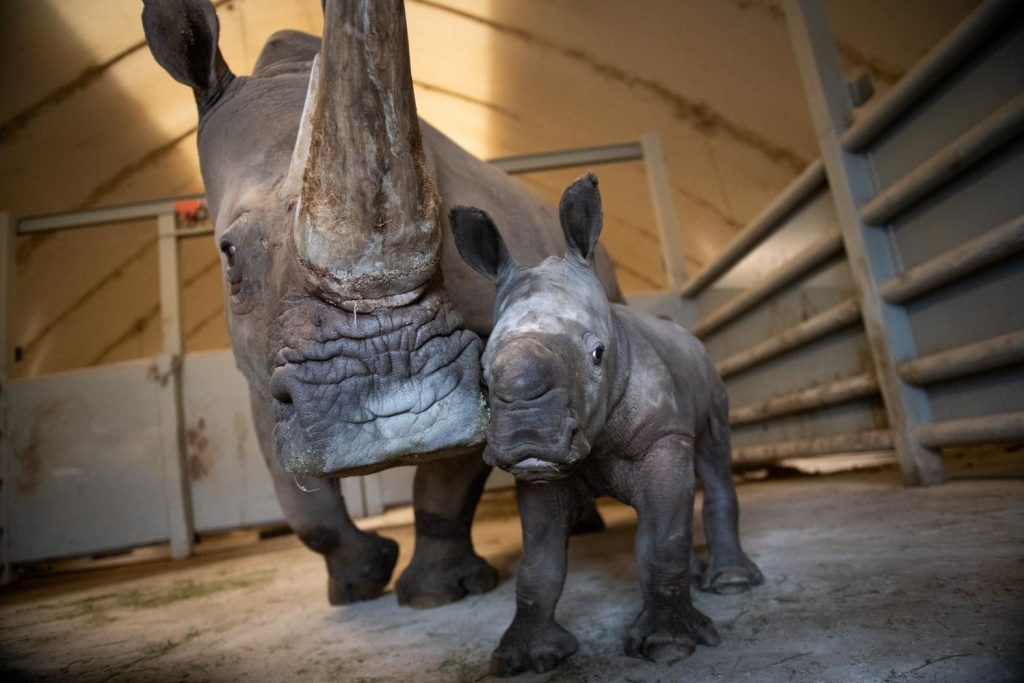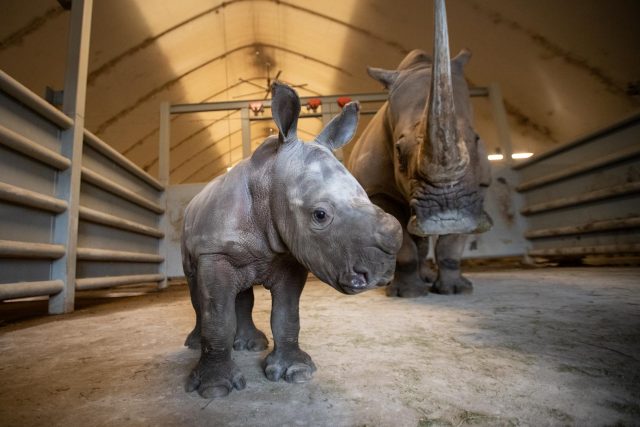Cumberland, OH – There’s a baby boom of sorts happening at The Wilds and the team is buzzing with excitement as they celebrate the birth of a third white rhinoceros. The male calf was born on December 24, 2020 in the rhinos’ large, heated barn. This calf is the 25th white rhino to be born at The Wilds.
The male calf and his mother, 16-year-old Zenzele, also born at The Wilds, are doing well. The calf appears to be strong and is nursing alongside his mother.

Zenzele, a seasoned mother, is doing well and watching after her little one. This is Zenzele’s fifth calf and the seventh calf that father, Roscoe, has sired. Roscoe was born at the Knoxville Zoo. He moved to the Seneca Park Zoo when he was 2 years old and has been living at The Wilds since 2014.
It was a busy December at The Wilds! On December 9, a female white rhino calf was born to mother, Kifaru, and on December 18, a male white rhino calf was born to mother, Kali. All three calves were sired by Roscoe. The Animal Management team says that the two older calves have been physically introduced to one another, taking part in fun and energetic playdates. They have also met the most recent arrival through the fences and will have a chance to play with him, too. The names of the three calves will be announced soon!
The Wilds is the only facility outside of Africa that has rhinos born four and five generations removed from their wild-born ancestors. That success continues with this latest birth. Zenzele was the very first rhino to be born at The Wilds and she has lived at The Wilds her entire life. Two of her daughters and two of her granddaughters are still in our herd at The Wilds. This latest newborn is the 11th fourth generation calf.

The pairings of Zenzele and Roscoe was recommended through the Association of Zoos and Aquariums’ (AZA) Species Survival Plan® (SSP). This program is designed to maintain a sustainable population and genetic diversity of threatened and endangered species in human care. The Wilds has also welcomed the births of eight Asian one-horned rhinos since 2005. The most recent Asian one-horned rhino calf, a female named Rohini, was welcomed into The Wilds’ family on August 24, 2019.
“Three baby white rhinoceros calves born in one month—we’re going to have our hands full!” said Dr. Jan Ramer, vice president of The Wilds. “These babies and the rest of our southern white rhino herd are wonderful ambassadors for their wild cousins, giving our guests the opportunity to connect with and appreciate these magnificent animals. We are proud to be leaders within the zoological community in helping to sustain populations of white rhinoceros through the addition of this latest calf.”
“The multigenerational herd is a true testament to our Animal Management team’s expertise and the great care they provide to the animals. White rhinos continue to face many challenges in their native range, and the arrival of each calf is a cause for celebration. Each birth is vital in protecting the future of the species,” said Columbus Zoo and Aquarium President/CEO Tom Stalf.
The white rhino population had dwindled to an estimated 50 to 200 individuals at the beginning of the 20th century. Still, through conservation efforts, the population of white rhinos in their native range in Africa has rebounded to about 20,400 animals. However, even with the increase in numbers, the species remains classified as near threatened by the International Union for Conservation of Nature (IUCN). All five remaining rhino species in Africa and Asia (white rhinoceros, black rhinoceros, greater one-horned rhinoceros, Javan rhinoceros and Sumatran rhinoceros) are killed by poachers who sell rhino horn for ornamental or traditional medicinal purposes even though there are no scientifically proven health benefits for its use. The horns are made of keratin—the same substance that makes up fingernails and hair. The International Rhino Foundation estimates that one rhino is killed every 10 hours for its horn.
White rhino calves are born after a gestation of 16 months and they can grow to be 4,000 pounds and six feet tall at their shoulder. Their habitats typically consist of plains or woodlands, interspersed with grassy openings. Through reintroduction efforts, their native range has been established in southern and eastern African countries.
Their physical characteristics are two pointed horns and a wide mouth suitable for grazing. The name white rhinoceros originated from the Afrikaans word describing the animal’s mouth – wyd, meaning “wide.” Early English settlers in South Africa misinterpreted the word wyd for “white.”
To further protect the future of rhinos, The Wilds and the Columbus Zoo has provided more than $218,000 in the last five years in support of conservation projects benefiting rhinos in their native ranges, such as monitoring black and white rhinos in Zimbabwe’s Lowveld region through the International Rhino Foundation, protecting black rhinos in the Ngulia Rhino Sanctuary in Kenya through the African Wildlife Foundation and habitat restoration focused on the shortgrass that white rhinos eat through the White Rhinos: Rhinoceros Fund Uganda.
Guests may have the opportunity to view the calves and their mothers, along with the other rhinos in the rhino barn during a Winter at The Wilds Tour. Tours are available at 11 a.m. and 2 p.m. through April. Please note that reservations must be made at least 72 hours in advance.










